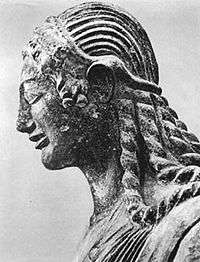Etruscan numerals
| Numeral systems |
|---|
 |
| Hindu–Arabic numeral system |
| East Asian |
| Alphabetic |
| Former |
| Positional systems by base |
| Non-standard positional numeral systems |
| List of numeral systems |
The Etruscan numerals were used by the ancient Etruscans. The system was adapted from the Greek Attic numerals and formed the inspiration for the later Roman numerals via the Old Italic script.
| Etruscan | Arabic | Symbol * | Old Italic |
|---|---|---|---|
| θu | 1 | 𐌠 | |
| maχ | 5 | 𐌡 | |
| śar | 10 | 𐌢 | |
| muvalχ | 50 | 𐌣 | |
| ? | 100 | 𐌟 |
There is very little surviving evidence of these numerals. Examples are known of the symbols for larger numbers, but it is unknown which symbol represents which number.
Thanks to the numbers written out on the Tuscania dice, there is agreement about the fact that zal, ci, huθ and śa are the numbers up to 6 (besides 1 and 5). The assignment depended on the answer to the question whether the numbers on opposite faces on Etruscan dice add up to seven, like nowadays. Some dice found did not show this proposed pattern.
An interesting aspect of the Etruscan numeral system is that some numbers, as in the Roman system, are represented as partial subtractions. So "17" is not written *semφ-śar as users of the Hindu-Arabic numerals might reason. We instead find ci-em zaθrum, literally "three from twenty". The numbers 17, 18 and 19 are all written in this way.
The general consensus
The general agreement among Etruscologists nowadays is the following (except about which of huθ and śa were "four" or "six", which has always been under discussion; see below the new results):
| Etruscan | Arabic |
|---|---|
| θu | 1 |
| zal | 2 |
| ci | 3 |
| huθ | 4 |
| maχ | 5 |
| śa | 6 |
| semφ | 7 |
| *cezp | 8 |
| nurφ | 9 |
| śar | 10 |
| *θuśar | 11 |
| *zalśar | 12 |
| *ciśar | 13 |
| huθzar | 14 |
| *maχśar | 15 |
| *śaśar | 16 |
| ciem zaθrum | 17 |
| eslem zaθrum | 18 |
| θunem zaθrum | 19 |
| zaθrum | 20 |
| cealχ | 30 |
| *huθalχ | 40 |
| muvalχ | 50 |
| śealχ | 60 |
| semφalχ | 70 |
| cezpalχ | 80 |
| *nurφalχ | 90 |
Archaeological evidence strongly supports the correspondence 4/huth and 6/sa. For instance, in the frescos of the Tomb of the Charons in the Monterozzi necropolis, on a hill east of Tarquinia, four Charons are represented, each one accompanied by an inscription: next to the fourth Charon, the text reads charun huths ("the fourth Charon"). In the same necropolis, in the Tomb of the Anina, which contains six burial places, an inscription reads: sa suthi cherichunce, which has been translated as: "he built six tombs/sepulchres". [1] However, other scholars disagree with this attribution. In this connection, in October 2011, Artioli and colleagues presented evidence from 93 Etruscan dice "allowing the firm attribution of the numeral 6 to the graphical value huth and 4 to sa".[2]
In 2006, S. A. Yatsemirsky presented evidence that zar = śar meant ‘12’ (cf. zal ‘2’ and zaθrum ‘20’) while halχ meant ‘10’. According to his interpretation, the attested form huθzar was used for ‘sixteen’, not ‘fourteen’, assuming huθ meant four.[3]
Much debate has been carried out about a possible Indo-European origin of the Etruscan cardinals. In the words of Larissa Bonfante (1990), "What these numerals show, beyond any shadow of a doubt, is the non-Indo-European nature of the Etruscan language".[4] Conversely, other scholars, including Francisco R. Adrados, Albert Carnoy, Marcello Durante, Vladimir Georgiev, Alessando Morandi and Massimo Pittau, have proposed a close phonetic proximity of the first ten Etruscan numerals to the corresponding numerals in other Indo-European languages.[5][6] Italian linguist and glottologist Massimo Pittau has argued that "all the first ten Etruscan numerals have a congruent phonetic matching in as many Indo-European languages" and "perfectly fit within the Indo-European series", supporting the idea that the Etruscan language was of Indo-European origins.[7]
See also
References
- ↑ Pallottino, M., "Un gruppo di nuove iscrizioni tarquiniesi e il problema dei numerali etruschi", Studi Etruschi 1964, pages 121-122.
- ↑ Artioli, G., Nociti, V., Angelini, I., "Gambling with Etruscan Dice: a Tale of Numbers and Letters", Archaeometry, Vol. 53, Issue 5, October 2011, pages 1031–1043 (Abstract).
- ↑ Etruscan numerals: problems and results of research (PDF), S. A. Yatsemirsky
- ↑ Bonfante, L.,Etruscan, University of California Press (Berkeley and Los Angeles, 1990), page 22.
- ↑ Carnoy A., La langue étrusque et ses origines, L'Antiquité Classique, 21 (1952), page 326. ()
- ↑ Morandi, A., Nuovi lineamenti di lingua etrusca, Erre Emme (Roma, 1991), chapter IV.
- ↑ Pittau, M., "I numerali Etruschi", Atti del Sodalizio Glottologico Milanese, vol. XXXV-XXXVI, 1994/1995 (1996), pages 95-105. ()
External links
| Wikimedia Commons has media related to Etruscan numerals. |
- http://users.tpg.com.au/etr/etrusk/tex/grammar.html#num
- http://www.mysteriousetruscans.com/language.html
